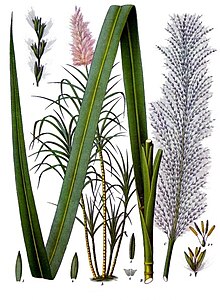Characteristics:
– Sugarcane is a widely produced primary crop globally
– It is a tropical grass with lateral shoots leading to multiple stems
– Stems grow to 3-4 meters in height and 5 cm in diameter
– A mature cane stalk contains fiber, soluble sugars, nonsugar carbohydrates, and water
– Successful cultivation depends on various factors like climate, soil, irrigation, and pest management
History:
– Sugarcane was an ancient crop for Austronesian and Papuan people
– Introduced to various regions by Austronesian sailors and traders
– Sugar trade began in India and expanded to the Caribbean and other regions
– Sugar plantations led to migrations and labor exploitation
– Brazil is the largest producer, with sugarcane accounting for 79% of global sugar production
Commercial Use:
– Sugarcane species are interbreedable, with major cultivars being hybrids
– White sugar is produced in specialized mill factories
– Sugarcane reeds have various uses like making pens, mats, and thatch
– The flower head of Saccharum edule is consumed in Southeast Asia
– Sugarcane is increasingly used to produce ethanol for biofuel
Economic Importance:
– Sugarcane is the world’s largest crop by production quantity
– Brazil contributes 40% of the global sugarcane production
– 70% of sugar globally comes from Saccharum officinarum and its hybrids
– Sugarcane accounts for 79% of global sugar production
– Ethanol production from sugarcane is projected to surpass white sugar production
Cultivation:
– Sugarcane is a perennial tropical grass with unique growth patterns
– Stems develop into cane stalks, making up 75% of the plant
– Cane stalks contain fiber, soluble sugars, nonsugar carbohydrates, and water
– Cultivation success relies on factors like climate, soil, irrigation, and pest management
– Selecting specific varieties and timing harvests are crucial for successful cultivation
Sugarcane or sugar cane is a species of tall, perennial grass (in the genus Saccharum, tribe Andropogoneae) that is used for sugar production. The plants are 2–6 m (6–20 ft) tall with stout, jointed, fibrous stalks that are rich in sucrose, which accumulates in the stalk internodes. Sugarcanes belong to the grass family, Poaceae, an economically important flowering plant family that includes maize, wheat, rice, and sorghum, and many forage crops. It is native to the warm temperate and tropical regions of India, Southeast Asia, and New Guinea.

Sugarcane was an ancient crop of the Austronesian and Papuan people. It was introduced to Polynesia, Island Melanesia, and Madagascar in prehistoric times via Austronesian sailors. It was also introduced to southern China and India by Austronesian traders around 1200 to 1000 BC. The Persians and Greeks encountered the famous "reeds that produce honey without bees" in India between the sixth and fourth centuries BC. They adopted and then spread sugarcane agriculture. Merchants began to trade in sugar, which was considered a luxurious and expensive spice, from India. In the 18th century, sugarcane plantations began in the Caribbean, South American, Indian Ocean, and Pacific island nations. The need for sugar crop laborers became a major driver of large migrations, some people voluntarily accepting indentured servitude and others forcibly imported as slaves.
Grown in tropical and subtropical regions, sugarcane is the world's largest crop by production quantity, totaling 1.9 billion tonnes in 2020, with Brazil accounting for 40% of the world total. Sugarcane accounts for 79% of sugar produced globally (most of the rest is made from sugar beets). About 70% of the sugar produced comes from Saccharum officinarum and its hybrids. All sugarcane species can interbreed, and the major commercial cultivars are complex hybrids.
White sugar is produced from sugarcane in specialized mill factories. Sugarcane reeds are used to make pens, mats, screens, and thatch. The young, unexpanded flower head of Saccharum edule (duruka) is eaten raw, steamed, or toasted, and prepared in various ways in Southeast Asia, such as certain island communities of Indonesia as well as in Oceanic countries like Fiji. The direct use of sugar cane to produce ethanol for biofuel is projected to potentially surpass the production of white sugar as an end product.
